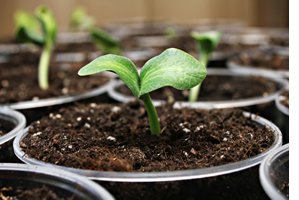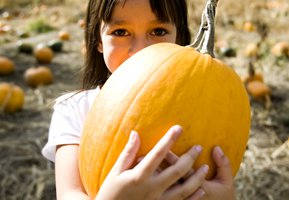A.Vogel search
When the internal search is activated, personal data such as your IP address is transmitted to our search engine Cludo. Data is thus transferred to a third country. Please click here if you want to display the internal search. You can find more information on data protection here: Privacy policy.
How to grow pumpkin
Want to grown your own pumpkins? Learn how to grow pumpkins with our growing tips and how to harvest and store them once grown.
Pumpkin growing, although better suited to more temperate climates, is perfectly possible in Canada. In fact the Canada's largest recorded home grown pumpkin weighed-in at a monstrous 821.5 kilograms! You may not have set your sights quite as high as that but with a little care and the right timing you can grow pumpkins in your own vegetable patch, or even in a pot, for adding to an array of recipes and for carving into Halloween lanterns. Many varieties are available and depending on what you have planned for your pumpkin post harvest (and once ripe) pumpkins can be stored for as long as six months.
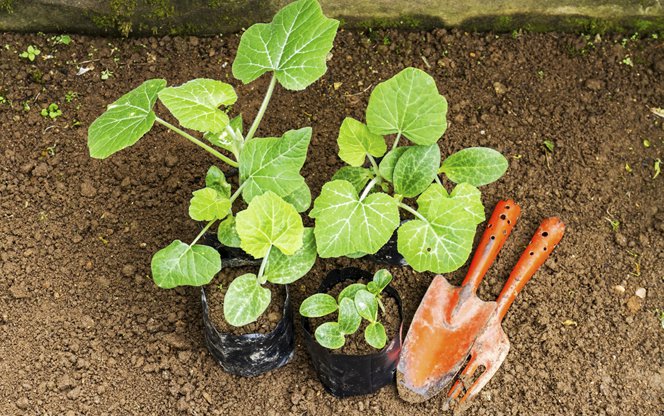 Growing pumpkins outside
Growing pumpkins outside
Pumpkins thrive best when they are warm and need a day-time temperature of over 17C and a night-time temperature of at least 15C, (at least until they are planted out) so in Canada it would be wise to start your pumpkins off inside in April, to be moved outside when your seedlings are stronger and the temperature has risen (approx. June).
- Sow your pumpkins seeds on their sides in small pots of compost (you can try 2 seeds per pot to double the chance of success!), at a depth of approximately 2.5cm
- Put your small pots in a propagator, or you can seal the pots inside a plastic bag in a warm room until germination, which should take 5-7 days
- Once germinated, you should continue to grow your pumpkin plants for around 4 weeks indoors until they are large enough to be transplanted outdoors (when it is warm enough)
- As pumpkins are sensitive to the cold, you should gradually acclimatise them to the outdoors over 7-10 days before transplanting them into warm, well-drained soil with some compost added to the soil in full sun and sheltered from the wind
- Choose a spot where there is plenty of space for sprawling vines, making sure there is a distance of at least 1 - 3 metres between your plants. Keep them well watered until they are established
- If your garden space is limited, you can plant them on the edge of the garden and encourage the vines to grow across your lawn or fence using wire. Or try the lovely miniature pumpkins varieties, which also look and taste great
- After a few weeks you should give your plants some fertilizer, at which point they should have started to produce long stems, which can be trained in a circle around the plant to stop them from spreading too far. Pumpkin plants have deep roots, so can find their own water in the soil, but if it is very dry some extra watering may be required.
Our top pumpkin growing tips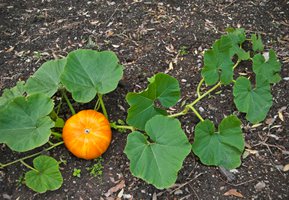
- Pumpkins can be prone to rotting if they are sitting in damp ground. You can raise them off of the ground if it’s wet and sit them on wooden boards to keep them dry
- If there's any risk of early frost you can protect your pumpkins with straw
- Give your plants a boost with fertilizer or plant food, watering regularly throughout the growing season (but not so much once they’ve been transplanted outside)
- If you're growing larger pumpkin varieties you can use wire to train your shoots as they develop. Pumpkin vines can spread fast and grow far and wide (up to 40 feet away from where the plant itself is!)
- As your pumpkins develop you can turn them to create an even shape (although take care to not to damage the vine or stems, which are delicate).
- Even though they may look tough, handle your pumpkins gently to avoid bruising, as this will affect their quality and flavour
- If you get vines and flowers but no pumpkins it could mean that you need more bees in your garden to pollinate the flowers, so why not grow some colorful flowers next to your pumpkin patch to attract more bees and butterflies.
Harvesting and storage
When?
You should leave your pumpkin on the plant for as long as possible to mature. You will know it is ripening when the skin is very tough and turns a deep, solid color (orange for the most common varieties). To test for maturity press the pumpkin with your thumb; if it’s ripe the rind will feel hard and sound hollow. The skin should also be able to withstand pressure from your fingernail. As a rough guide it should take around 100 days from planting your pumpkin outside to it reaching full maturity.
How?
To harvest the pumpkin cut it carefully off the vine using pruners or a sharp knife. Take care not to cut too close to the pumpkin however, as leaving a long stem (of around 10cms) will increase its shelf life. Store your pumpkins somewhere dry, cool and dark where they will keep for up to six months.
Growing pumpkins in pots
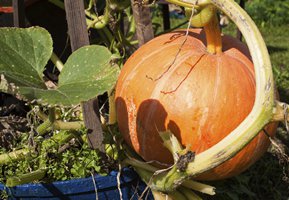 If you don’t have garden space, but still want to give pumpkin growing a try, you can actually use a growbag or a pot/container, as long as it is large enough: at least 45cms wide and able to hold around 70 litres. Use high quality potting soil and make sure the pot has good drainage (lots of holes to let water out); pumpkins like a lot of water, but hate to sit in wet soil (this can cause them to go mouldy). Only one seed should be planted per pot. Place the pot in the sunniest spot you can find, and remember, even the smaller varieties need a lot of light to develop. Your plant should be getting at least six hours of sunlight a day. Water your plant regularly, and feed it with diluted liquid fertilizer every couple of weeks whilst it is developing and until the fruit appears. Within three months you should be the proud owner of a healthy and delicious pumpkin!
If you don’t have garden space, but still want to give pumpkin growing a try, you can actually use a growbag or a pot/container, as long as it is large enough: at least 45cms wide and able to hold around 70 litres. Use high quality potting soil and make sure the pot has good drainage (lots of holes to let water out); pumpkins like a lot of water, but hate to sit in wet soil (this can cause them to go mouldy). Only one seed should be planted per pot. Place the pot in the sunniest spot you can find, and remember, even the smaller varieties need a lot of light to develop. Your plant should be getting at least six hours of sunlight a day. Water your plant regularly, and feed it with diluted liquid fertilizer every couple of weeks whilst it is developing and until the fruit appears. Within three months you should be the proud owner of a healthy and delicious pumpkin!
A.Vogel Blog – Natural and Healthy
Inspiration for a healthy life!




